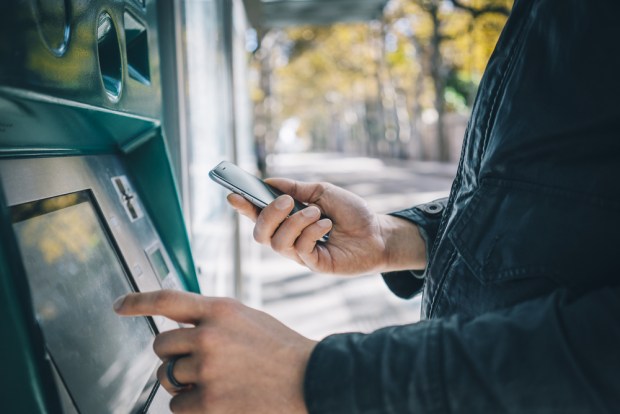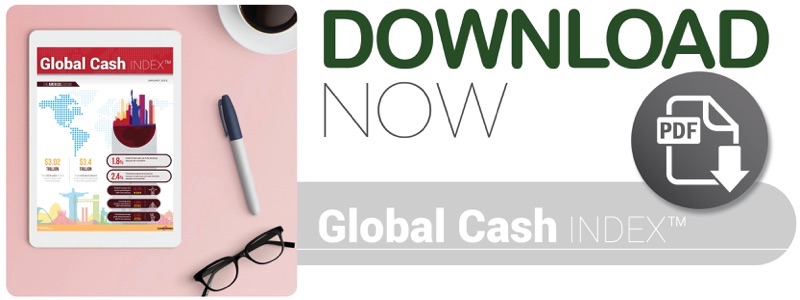How Cross River Bank Keeps Cash Flowing

More than $3 trillion in cash is used to make purchases across the Americas every year — even as digital payment methods continue to advance. The latest Global Cash Index: Americas Edition includes 200-plus data points that show cash usage on the rise in the U.S., Brazil and Mexico, and its projected growth in usage over the next four years — and why — despite strong digital momentum. Ben Isaacson, SVP and general manager of payments at Cross River Bank, told PYMNTS that the rise in cash usage also helps to explain why the bank’s new smartphone/smart code cash access at ATMs service is a hit with customers.
In the financial services world, most buzzworthy payment innovations are frequently aimed at rendering older, physical financial concepts moot. This includes checks, brick-and-mortar bank branches, ATM cards and, yes, cash.
But not all financial innovations are focused on making such concepts obsolete. Some companies, like Cross River Bank of Teaneck, New Jersey, have launched services to ease consumers’ access to physical cash notes by tapping into the convenience of the existing financial infrastructure.
That infrastructure is helping to keep cash a fixture of U.S. commerce today. In the most recent PYMNTS Global Cash Index, United States Analysis found that Americans spent $2.5 trillion in cash in 2015, a higher rate than that of Western European nations.
Given its high usage in the U.S., some financial institutions (FIs) see a need to innovate how their consumers access cash. PYMNTS recently spoke with Ben Isaacson, senior vice president and general manager of payments for Cross River Bank, who discussed how the FI’s newest offering addresses the needs of underbanked consumers and millennials, and why he believes it could spell trouble for the U.S. Postal Service (USPS).
The ATM Real Estate Advantage
Cross River teamed up with Mastercard in 2017 to launch Mastercard Cash Pick-Up, a disbursement service that delivers cash on behalf of businesses to vetted recipients through a network of ATMs.
According to Isaacson, the service is intended to offer businesses a new option to make cash payments by allowing recipients to pick them up at a nearby ATM. It can be used by businesses to send customer rebates and, in the case of consumers, can be used by family and friends to send emergency funds to one another. Other uses include social benefits disbursement, such as Social Security payments.
Businesses or individuals that need to send money or make payments can use Cash Pick-Up to initiate a request. Once the transaction is initiated, the sender’s bank is notified to send money to the recipient.
The service delivers a code to the recipient’s smartphone via text message. Once the code is entered at an enabled ATM, he or she can access the cash without using a debit card. It is intended to offer consumers a convenient way to access funds by tapping into a network of thousands of ATMs, Isaacson said.
“What ATMs have is a big and broad real estate footprint,” he added. “So, anywhere you are in the country, you’re [likely] just a few blocks from an ATM.”
In addition to winning over consumers with the promise of easy cash access, Isaacson noted the joint service is also appealing to newer financial players. These emerging players often lack the broad physical infrastructure needed to reach consumers wherever they might go.
“We’re seeing a lot of interest from emerging FinTechs and payment companies who really like the physical footprint of the ATM network,” he said. “Because they don’t have extensive brick-and-mortar infrastructure, the ability to send money to a place where consumers can physically go and pick it up is very attractive to them.”
End of the Mail Drop?
For businesses and individuals initiating payments, Cross River’s Cash Pick-Up service can offer an additional cost-saving benefit. By alerting recipients to pick up their cash at a local ATM, these parties can avoid the costs associated with issuing checks, and the consumer frustration that stems from being forced to wait by their mailboxes.
Isaacson noted that many businesses end up making wage and rebate payments in this manner, and the reason often involves accessing consumers’ checking accounts and routing numbers. In some cases, such numbers are difficult to remember, and in others, consumers might not know how to find the information on a digital platform. Some might be uncomfortable sharing the information, while others might not have a checking account at all.
It’s far more difficult for these consumers to get set up for electronic payments without their account information, though. As a result, some businesses and employers are often forced to use the U.S. mail system to make payments via paper check.
Isaacson pointed out that smartphone numbers are more easily accessible and shareable than checking account numbers, adding that it makes the Cash Pick-Up service – and the cash element – even more appealing to tech-savvy millennial users.
“Millennials love getting text messages saying your money’s there and [they] just need to go to the nearest ATM,” he said.
Another benefit is that it helps businesses and senders rely less on USPS to deliver payments. While a service that encourages the use of cash might seem counterintuitive, Cross River Bank believes consumers will use it if it can take postal deliveries out of the equation and more quickly distribute payments.
“While the end result is more cash in the system, what it’s really doing is replacing a manual paper-based distribution system – the U.S. mail – with a mobile, electronic payment,” Isaacson said.
Will the service help to #KillTheMail and #KillTheCheck at the same time? Time will tell.
Assisting the Unbanked and Underbanked
Companies can use Cash Pick-Up to more easily distribute funds to customers, Isaacson said, and family and friends can also use it to send money to each other – thus saving them a trip to Western Union, or a MoneyGram that only operates during specific hours.
The service can also help unbanked consumers transact without hassles. According to the Federal Deposit Insurance Corporation (FDIC)’s Consumers and Mobile Financial Services 2016 report, approximately 9 percent of Americans do not have access to banking services like checking, savings or money market accounts. Meanwhile, 22 percent were “underbanked,” meaning they had a bank account, but also relied on alternative financial services like money orders, cash checking and payday loans.
For these underbanked consumers, Cash Pick-Up enables access to funds without requiring a bank account – just a smartphone. The same FDIC report found that 70 percent of underbanked consumers had access to a smartphone, compared to 40 percent for unbanked respondents.
“Being able to pay using a cell phone number will allow [businesses] to reach a population that doesn’t have bank accounts,” Isaacson explained.
A service that enables recipients to access cash at the nearest ATM helps put the unbanked and underbanked populations on stronger financial footing.
“We look at it from a distribution perspective,” he said. “Even if you don’t have a bank account, you can still go to an ATM and get money out.”
Allowing the underbanked access to fast financial services also points to the role cash continues to play in the economy – even as it faces increased competition from newer financial tools.
“Cash still works everywhere,” Isaacson noted. “People use less of it, but they still need some of it.”
While there are available alternatives to cash, a widespread network of ATMs and a population that relies on quick access to money indicates that cash usage will continue to persist in the U.S. for years to come.
About the Index
The Global Cash Index™, a Cardtronics collaboration, focuses on the use of cash for making payments and as a payment method that equally plays a role with cards, checks, direct debit and other methods consumers and businesses use to settle up. Unlike most reported estimates of cash, our proprietary data analysis focuses on the use of cash for making payments rather than hoarding.
